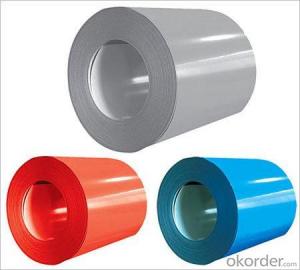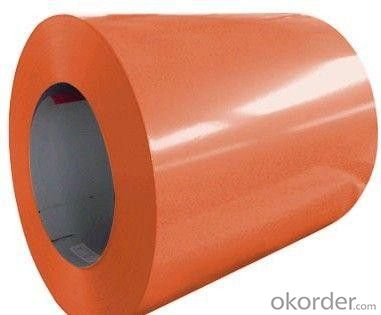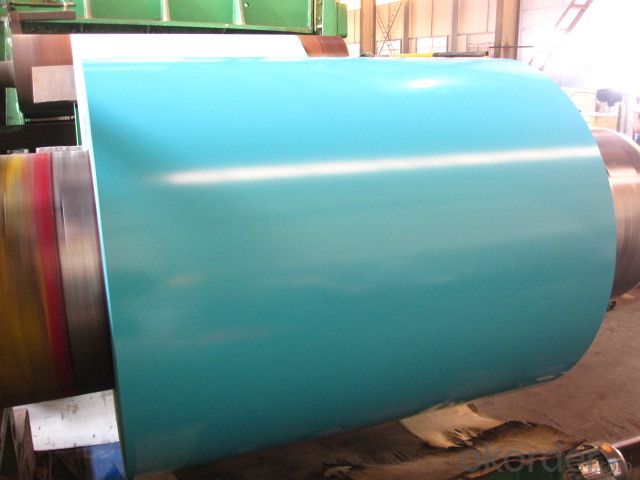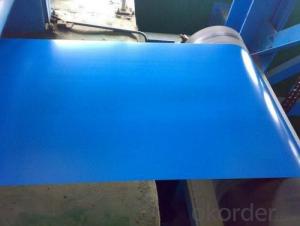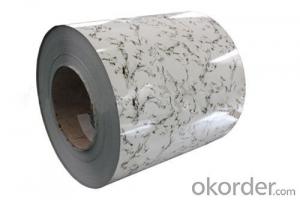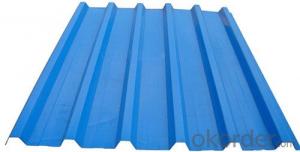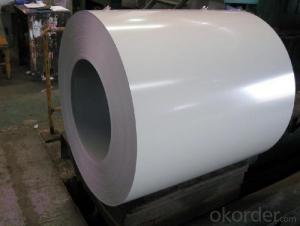Prepainted steel coils, Hot-dipped Galvanized, RAL System, with good corrosion resistance
- Loading Port:
- Shanghai
- Payment Terms:
- TT OR LC
- Min Order Qty:
- 25 m.t.
- Supply Capability:
- 30000 m.t./month
OKorder Service Pledge
OKorder Financial Service
You Might Also Like
ppgl steel coil
Thickness: 0.15-0.6mm
Width:600-1250mm
Color:all Ral color
Hardness: Soft to full hard
Applications
1. Construction and building: roofing; ventilating duct; handrail; partition panel;etc.
2. Electric appliance: refrigerator; washing machine; refrigerator; DVD;etc.
3.Transportation: oil tank; road sign; etc.
4.Agriculture:barn; etc.
5.Others:vending machine; game machine; etc.
1.PPGL Steel information
Standard | ASTM A653, JIS G3302,GB/T3830-2006 |
Grade | DX51D,SGCC,SPCC,SGHC |
Thickness | 0.18mm--1.2mm |
Width | 400-1250mm(usual size:914mm,1000mm,1200mm,1219mm,1250mm,) |
Base metal | Galvanized steel coils, |
Zinc coating | 40-80gsm |
Coil ID | 508mm,610mm |
Coating thickness | Top:17-25um back:5-8um |
Color options | Ral number or as per your request |
Packing | Standard seaworthy export packing: 3 layers of packing, inside is kraft paper, water plastic film is in the middle and outside GI steel sheet to be covered by steel strips with lock, with inner coil sleeve. |
Delivery | Within 10-15days after signing contract |
Price | FOB&CNF&CIF price |
Payment terms | TT or L/C |
Monthly supply | 30000MT per month |
Application: | workshop, storeroom, roofing,kiosk... |
- Q: What are the challenges in coil recoiling for high-strength steel?
- There are several challenges associated with coil recoiling for high-strength steel. Firstly, high-strength steel is known for its increased hardness and strength, which makes it more difficult to coil compared to regular steel. The higher tensile strength of high-strength steel puts more stress on the recoiling equipment, leading to potential damage or failure of the machinery. Secondly, high-strength steel tends to have lower ductility, meaning it is less able to withstand deformation without fracturing. Recoiling high-strength steel coils requires careful handling and control to prevent any excessive bending or stretching that could cause the material to break or crack. Another challenge is the shape memory effect of high-strength steel. This phenomenon causes the material to return to its original shape after being deformed. While this property can be advantageous in some applications, it complicates the recoiling process as the steel coil may resist being reshaped into a new coil form. Furthermore, high-strength steel often has a more complex microstructure compared to regular steel, with different phases and grain boundaries. This complexity can make the recoiling process more challenging as it may affect the material's mechanical properties and response to deformation. Lastly, the surface finish of high-strength steel coils is critical for many applications. Recoiling can introduce surface defects, such as scratches or marks, which may affect the functionality or appearance of the final product. Therefore, maintaining a high-quality surface finish during the recoiling process is a significant challenge. In summary, the challenges in coil recoiling for high-strength steel include the increased stress on recoiling equipment, lower ductility, shape memory effect, complex microstructure, and the need for a high-quality surface finish. Overcoming these challenges requires specialized equipment, precise control, and careful handling to ensure the integrity and quality of the recoiled high-strength steel coils.
- Q: How are steel coils used in the manufacturing of industrial boilers?
- Steel coils are used in the manufacturing of industrial boilers as they provide structural support and ensure the durability and strength of the boiler. These coils are often used to construct the boiler's pressure vessel, which contains the water or steam under high pressure. Additionally, steel coils are used for various components such as tubes, pipes, and flanges, which are integral to the functioning of the boiler. Overall, steel coils play a crucial role in the construction and performance of industrial boilers.
- Q: How do steel coils contribute to the energy infrastructure sector?
- Steel coils contribute to the energy infrastructure sector by serving as a crucial component in the construction and maintenance of power plants, oil and gas pipelines, and electrical transmission systems. These coils are used to manufacture various equipment and structures, such as turbines, generators, transformers, and transmission towers. Additionally, steel coils provide strength, durability, and corrosion resistance, ensuring the longevity and reliability of the energy infrastructure, ultimately supporting the efficient and uninterrupted supply of electricity, oil, and gas to meet the growing energy demands.
- Q: How long do steel coils typically last?
- The durability of steel coils is known to last for decades, as it is influenced by various factors including the quality of the steel, maintenance and care, as well as the specific application they are used for. The design of steel coils is generally focused on ensuring longevity by being resistant to corrosion. When properly cared for, regularly maintained, and used within recommended guidelines, steel coils can have a lifespan ranging from 20 to 50 years or more. However, external factors like exposure to harsh environments, extreme weather conditions, and the level of stress they endure can impact their longevity.
- Q: Why is steel used for building purpose and not any other metal?
- Steel is used for building purpose because of its steadfast quality. The steel has an intense resistance which renders it completely immune to dangers of corrosion, climatic variations, weather fluctuations and other environmental hazards, thereby making it the most suitable metal for exterior surface of the building. Internal structure of steel also helps the building to have strength at the core which enables it to stand erect for a longer time.
- Q: What are the different methods of corrosion protection for steel coils?
- There are several methods of corrosion protection for steel coils, including but not limited to: 1. Coating: Applying a protective layer such as paint, polymer, or zinc coating on the surface of the steel coil to prevent direct contact with corrosive agents. 2. Galvanizing: Immersing the steel coil in a bath of molten zinc, creating a protective coating that prevents corrosion. 3. VCI (Vapor Corrosion Inhibitor): Using volatile corrosion inhibitors that release molecules to form a protective layer on the steel coil, preventing corrosion. 4. Oil or Wax Coating: Applying a layer of oil or wax on the surface of the steel coil to act as a barrier against moisture and corrosive elements. 5. Cathodic Protection: Using sacrificial anodes or impressed current to protect the steel coil by providing a more easily corroded metal that attracts corrosion instead. 6. Desiccants: Placing desiccant materials such as silica gel or molecular sieves inside the packaging to absorb moisture and prevent corrosion. 7. Environmental Control: Maintaining controlled humidity levels, temperature, and proper ventilation in storage areas to minimize the risk of corrosion. 8. Proper Handling and Storage: Implementing safe handling practices during transportation and storing steel coils in dry, covered areas away from corrosive substances. It is important to select the appropriate method based on the specific application, environment, and desired level of protection for the steel coils.
- Q: I wanted to get a cheapo ring and I found one I like, but it's stainless steel. Is that bad? Will it get dull and tarnished fast?
- Stainless steel will never tarnish so you don't have to worry about it. It's a better choice than silver, for silver,you'll have to clean it with either a cleaner product or toothpaste. Oh yeah, and stainless steel has that cool and modern look.
- Q: What dangers were there for the steel workers in Pittsburgh under Carnegie?
- All manufacturing jobs of that era were incredibly dangerous, even textile work, but steel work was likely the worst. Men would fall into vats of molten metal, be crushed under huge metal bars, hit by cranes, burned by simple contact with any of the red hot pieces of metal flying all around, and most commonly, die from asphyxiation or lung ailments from the constantly burning fires. Heat stroke was a big killer, too. There was virtually no form of compensation, either for injured workers, or, in the case of death, for their families. The Bessemer method, which Carnegie introduced into the US, was hoped to improve conditions...instead, it merely improved output, and Carnegie's factories after 1900 worked 200,000 men, twelve hours a day, on wages that barely kept their families alive.
- Q: What are the different grades of steel used in coil production?
- There are several grades of steel used in coil production, including low carbon steel, high carbon steel, stainless steel, and alloy steel. Each grade has specific properties and characteristics that make it suitable for different applications and industries.
- Q: What is the thickness range of steel coils?
- The thickness range of steel coils can vary depending on the specific application, but it typically ranges from 0.005 inches to 0.5 inches.
Send your message to us
Prepainted steel coils, Hot-dipped Galvanized, RAL System, with good corrosion resistance
- Loading Port:
- Shanghai
- Payment Terms:
- TT OR LC
- Min Order Qty:
- 25 m.t.
- Supply Capability:
- 30000 m.t./month
OKorder Service Pledge
OKorder Financial Service
Similar products
Hot products
Hot Searches
Related keywords
